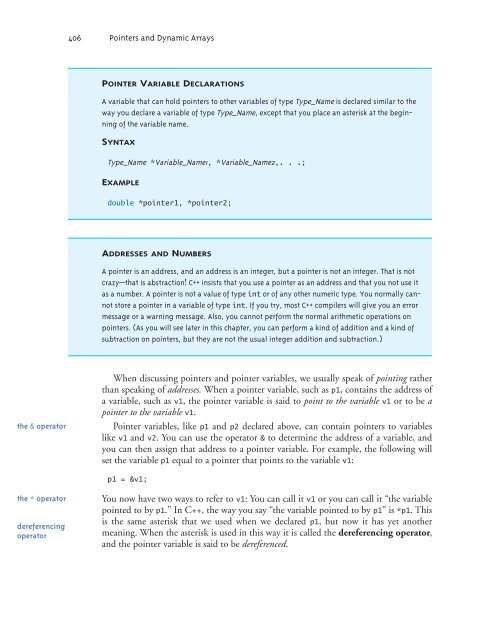Pointers and Dynamic Arrays
Pointers and Dynamic Arrays
Pointers and Dynamic Arrays
You also want an ePaper? Increase the reach of your titles
YUMPU automatically turns print PDFs into web optimized ePapers that Google loves.
the & operator<br />
the * operator<br />
dereferencing<br />
operator<br />
406 <strong>Pointers</strong> <strong>and</strong> <strong>Dynamic</strong> <strong>Arrays</strong><br />
POINTER VARIABLE DECLARATIONS<br />
A variable that can hold pointers to other variables of type Type_Name is declared similar to the<br />
way you declare a variable of type Type_Name, except that you place an asterisk at the beginning<br />
of the variable name.<br />
SYNTAX<br />
Type_Name *Variable_Name1, *Variable_Name2,. . .;<br />
EXAMPLE<br />
double *pointer1, *pointer2;<br />
ADDRESSES AND NUMBERS<br />
A pointer is an address, <strong>and</strong> an address is an integer, but a pointer is not an integer. That is not<br />
crazy—that is abstraction! C++ insists that you use a pointer as an address <strong>and</strong> that you not use it<br />
as a number. A pointer is not a value of type int or of any other numeric type. You normally cannot<br />
store a pointer in a variable of type int. If you try, most C++ compilers will give you an error<br />
message or a warning message. Also, you cannot perform the normal arithmetic operations on<br />
pointers. (As you will see later in this chapter, you can perform a kind of addition <strong>and</strong> a kind of<br />
subtraction on pointers, but they are not the usual integer addition <strong>and</strong> subtraction.)<br />
When discussing pointers <strong>and</strong> pointer variables, we usually speak of pointing rather<br />
than speaking of addresses. When a pointer variable, such as p1, contains the address of<br />
a variable, such as v1, the pointer variable is said to point to the variable v1 or to be a<br />
pointer to the variable v1.<br />
Pointer variables, like p1 <strong>and</strong> p2 declared above, can contain pointers to variables<br />
like v1 <strong>and</strong> v2. You can use the operator & to determine the address of a variable, <strong>and</strong><br />
you can then assign that address to a pointer variable. For example, the following will<br />
set the variable p1 equal to a pointer that points to the variable v1:<br />
p1 = &v1;<br />
You now have two ways to refer to v1: You can call it v1 or you can call it “the variable<br />
pointed to by p1.” In C++, the way you say “the variable pointed to by p1” is *p1. This<br />
is the same asterisk that we used when we declared p1, but now it has yet another<br />
meaning. When the asterisk is used in this way it is called the dereferencing operator,<br />
<strong>and</strong> the pointer variable is said to be dereferenced.

















